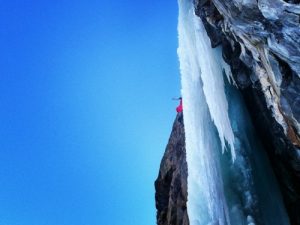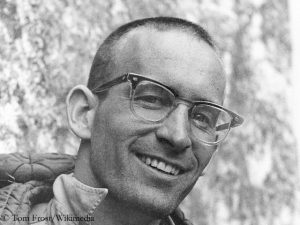Scherer: “Ice climbing is a metaphor”
Ice climbing is fascinating, but also dangerous. Two weeks ago, the Austrian extreme climber Thomas Bubendorfer survived with plenty of luck a ten-meter-fall from an icy waterfall in the Dolomites. The 54-year-old had landed in a creek bed and had suffered serious injuries. For a week, Bubendorfer was held in an artificial coma. Earlier this week, he was transferred to the Salzburg University Hospital. He is out of danger, addressable and does not have to be given artificial respiration anymore, said a hospital spokesperson.
Even before Thomas’ accident, I had talked to Matthias Scherer. The 42-year-old is a professional ice climber; since 1993 he has climbed more than 500 frozen waterfalls in Europe and Canada. Born in Frankfurt, he has been living and climbing along with his wife Tanja Schmitt in Cogne in the Aosta Valley, on the south side of Mont Blanc.
Matthias, is there something like a network between ice climbers, over which you communicate where the best ice conditions prevail?
Extreme ice climbing is like bigwave surfing. We have a similar community. There is a lively exchange between people who climb extreme routes. This is a very small group. I maintain regular contacts with ice climbers in Canada, Norway, and of course with the French scene. We are exchanging where it might be possible to climb. It’s like the surfers. You have to follow the ice, where the conditions are right.
Surfers are considered the mad dogs in sports. Are you the mad dogs among the climbers?
When we climb the big lines, this is very much linked to alpinism. Perhaps the purest form of alpinism when looking at the people doing it and their values.
In what sense?
In the sense that there is not much talk about it. It’s a very closed circle. Perhaps I am the one of those extreme ice climbers who is promoting himself the most. Many remain in the background, and they want to do it this way.
What is the reason?
Many want to share this moment only with themselves and the rope team. Actually, I think this is a pity. I find the stories we experience very important. On the one hand it is adventure, on the other hand it is a very good metaphor for what else we experience.
A metaphor for what exactly?
In these extreme lines – as I have climbed, for example, last winter in Norway with my wife Tanja Schmitt and her twin sister Heike – existential questions arise. The ice structure on which you are climbing can be so fragile that the entire rope team is in danger. Like so often in life, the question arises: Do you want to take the risk at this moment or do you think ahead, what can happen? On the one hand, there is the desire to leave everything behind, but on the other hand the need to remain reasonable. This is the challenge every person faces in life. In extreme ice climbing, it is put in a nutshell – at the moment when you have to decide.
It’s a narrow ridge in climbing, whether on rock or ice, trying to go to the limit, perhaps even beyond. Is there no danger of crossing the line?
Yes, especially in ice climbing. And that is precisely the art – or the criterion, which makes out a professional ice climber: the fact that over the years he is always going to the limit with passion and walking this ridge without falling. I have experienced it again and again that there were these comets in our discipline, which came up and then disappeared again very quickly. On the one hand because they lost motivation, on the other hand because they had accidents. This happens more often than in rock climbing, because the ice is an ephemeral [shortl-lived] medium. Even with 25 years of experience, there is still a high factor of unpredictability. The ice is continously changing. I can climb a waterfall three times a week and it’s different each time. A temperature rise or drop by five degrees Celsius can change the ice completely. A waterfall can not be climbed twice in the same way, which is the fascinating about ice climbing.
Is there, like in sports climbing, an age when you have simply passed your zenith because muscle power and springiness are on the decline?
In ice climbing, experience plays a very, very important role. It is an extreme mind game. Of course, it is also a question of power, but not as in sports climbing. If you can assess the ice quality correctly, you need significantly less power, because you remain more relaxed in your head. I often experience young ice climbers who are wasting their energy in stressful situations. On the other hand, I climb with friends like Steve Swenson, who is already over 60 years old and is still able to ice climb hard, because he has that easygoingness – the Zen, the ease of mind that is needed to stand on a freestanding ice pillar and to know that nothing will happen. In this respect you become stronger with age.











